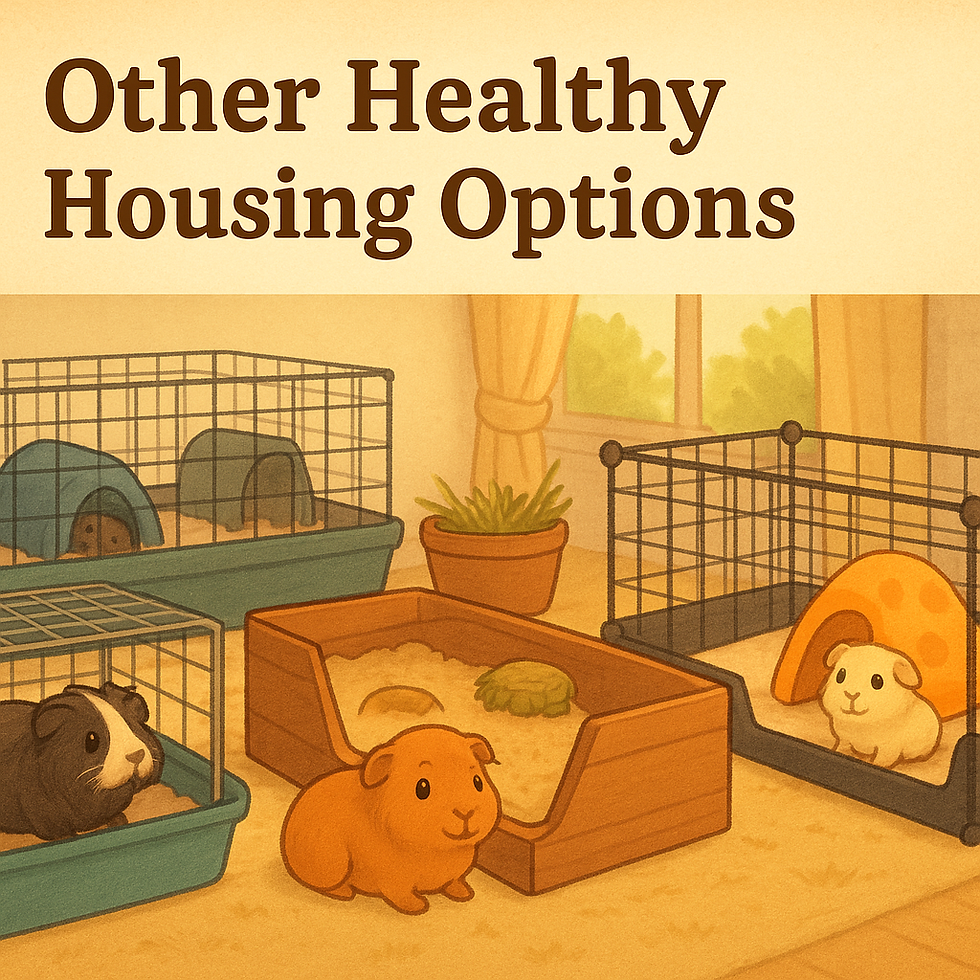Happy Homes: Creating a Healthy Guinea Pig Cage Setup
- Sarah Robarge

- Jul 13
- 3 min read
By The Cavy Whisperer

When it comes to guinea pig care, few things are more important than their habitat. A well-designed living space isn’t just about aesthetics—it’s essential for their physical health, emotional well-being, and ability to thrive. Let’s dive into what makes a great guinea pig Cage setup—and what to avoid.

The Gold Standard: Spacious, Safe, and Stimulating
🛠️ C&C Cages: The Favorite for a Reason
Cubes and Coroplast (C&C) cages are one of the most popular housing choices among guinea pig guardians, and for good reason:
Customizable: Build to suit any space—from modest apartments to piggy palaces.
Spacious: Far exceed the minimum size standards recommended by vets and rescues.
Well-ventilated: Open grids allow for excellent airflow.
Affordable DIY: With a few supplies and a little time, you can create a dream home for your herd.
Minimum size for two pigs:
7.5 square feet (1x2 meters) is the bare minimum, but 10.5+ square feet is ideal. Bigger is always better.
Bonus Tip: Add a second level for enrichment, not more floor space. Guinea pigs are ground dwellers and need plenty of flat, running room.

Other Healthy Housing Options
If C&C isn’t for you, here are some other safe choices:
Midwest Guinea Habitat: A ready-to-use cage that meets size minimums. Add extenders to increase space.
DIY Wooden Enclosures: So long as they’re waterproofed and escape-proof, wood setups with open tops can work well.
Room or Pen Setups: Free-roaming in a guinea pig-safe room or large pen (with chew-proof barriers) is a luxury lifestyle many pigs enjoy!

What to Avoid: Common but Unhealthy Setups
Not all housing labeled “small animal” is suitable for guinea pigs. Here’s what to skip:
❌ Aquariums or Glass Tanks
Poor ventilation = a buildup of ammonia and heat.
Restricted space = no room to run, popcorn, or play.
Overheating risk = glass traps warmth and can lead to heatstroke.
❌ Plastic Storage Bins
While great for transport, they’re not suitable for full-time living.
Lack of airflow, minimal space, and risk of chewing make them unsafe.
❌ Pet Store Cages
Many cages marketed for guinea pigs are too small.
A 24” x 12” cage is not even close to enough space for a single pig, let alone a pair.
Think of it this way: if your guinea pigs can’t run in a straight line for at least a few steps, the cage is too small.

Flooring & Bedding Matters Too
Even in the right-sized cage, the wrong bedding can cause problems. Choose:
Fleece liners (with an absorbent layer underneath)
Paper-based bedding (unscented and dust-free)
Aspen shavings (avoid cedar or pine with strong aromas)
Avoid:
Bare plastic floors (can cause sore hocks)
Scented or dusty litters (bad for respiratory health)

Final Wheek of Wisdom On Your Guinea Pig Cage Setup
Your guinea pig’s cage isn’t just a container—it’s their entire world. The more enriching, comfortable, and safe you make it, the happier (and healthier) your piggies will be. Think of their home as an investment in their well-being—and you’ll be rewarded with zoomies, popcorning, and lots of squeaky joy.
💚 Looking for something to spruce up your space? From cozy hoodies to whimsical wall art, check out our Guinea Pig Gift Shop for goodies that celebrate your love of cavies—while helping us continue to educate and advocate for better piggy care.





Comments